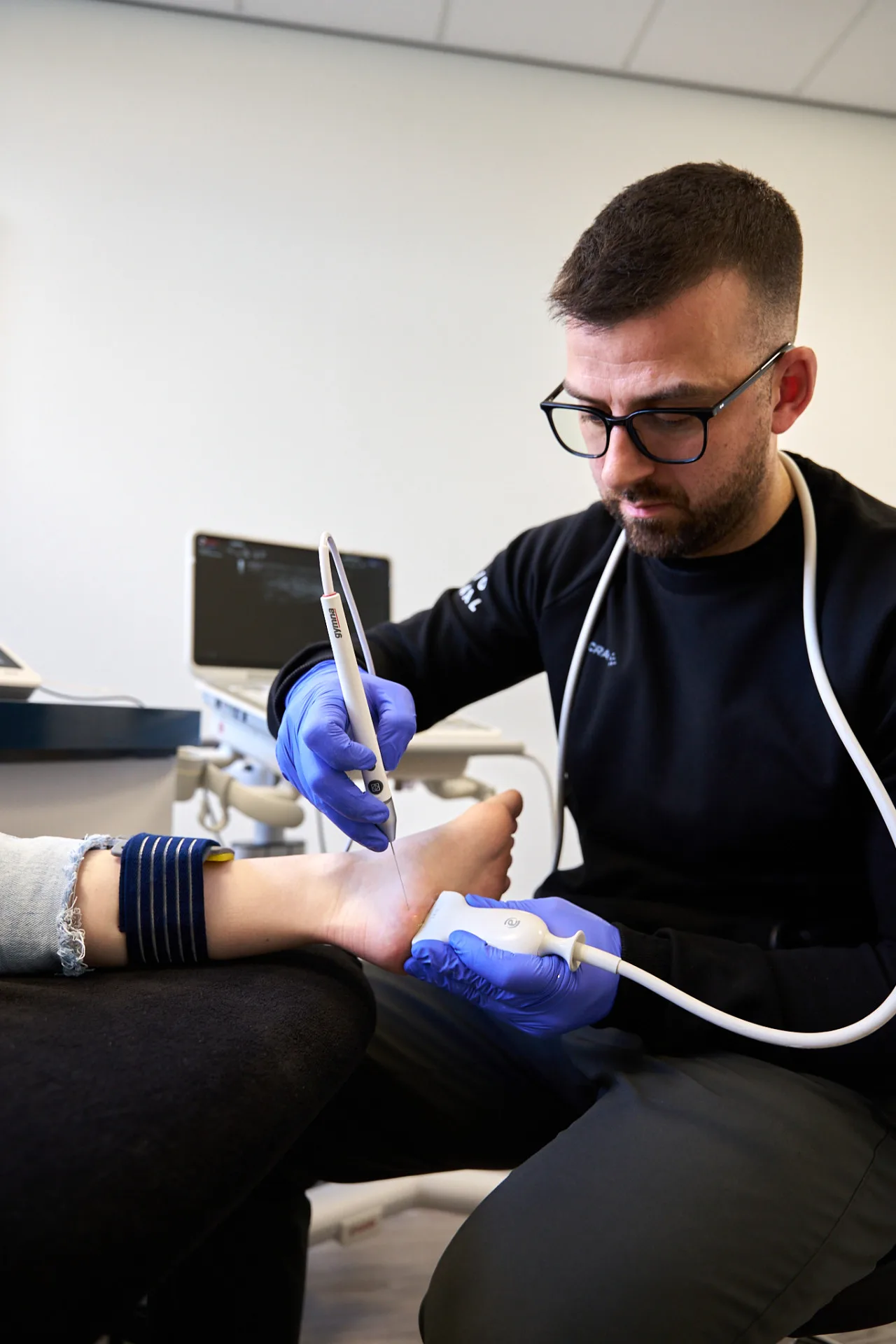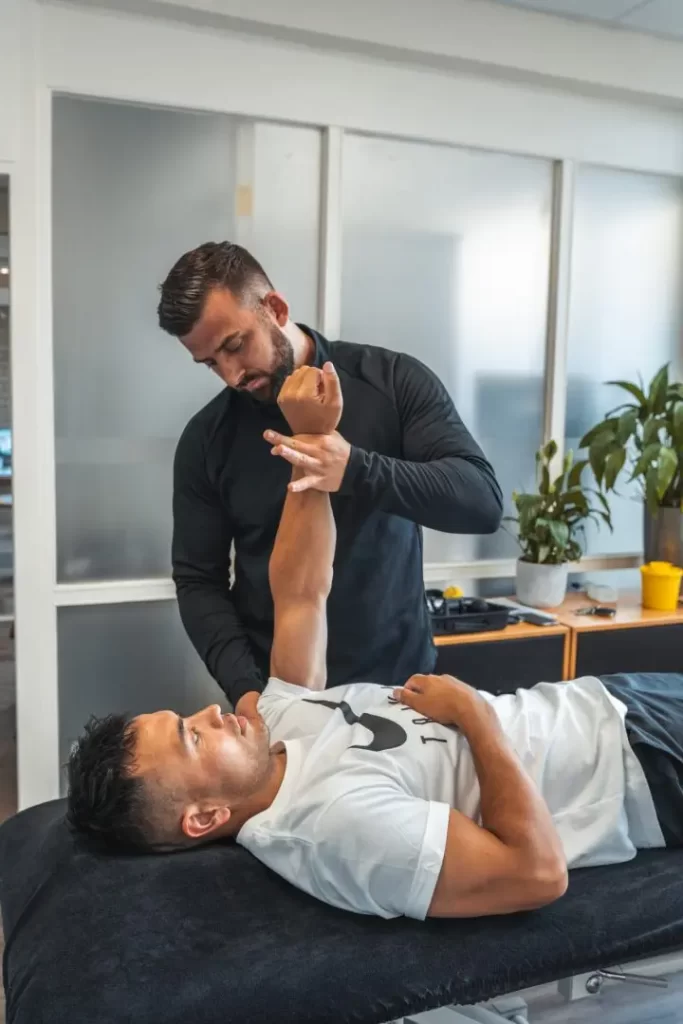Percutaneous electrolysis therapy

How does Percutaneous electrolysis treatment work?
During the treatment, a targeted electric current is applied through a needle into the damaged tissue. This triggers a number of processes that together promote recovery:
Change in pH:
The electric current causes the pH level in the treated area to rise. This means the area becomes less acidic and restores its natural balance. A normal pH level creates an optimal environment for recovery and helps the inflammatory response to run smoothly.
Improved blood circulation:
The stimulation causes more blood to flow to the damaged tissue. This increases the supply of oxygen and nutrients, while waste products are disposed of faster. Improved blood flow significantly speeds up the recovery process.
Stimulation of metabolites:
Metabolites are important substances involved in cell metabolism and tissue repair. Treatment promotes the migration of these substances to the lesion (the damaged area), supporting your body's natural healing processes.
Activation of tenocytes:
Tenocytes are specialised cells involved in making new collagen, the protein that provides strength and structure in tendons and muscles. The electrical stimulus activates these cells, allowing them to produce new, strong collagen fibres faster and more effectively.
Building healthy tissue:
As pH is restored, blood circulation improves, metabolites are transported to the damaged area and tenocytes are activated, a favourable environment is created for the synthesis of new tissue. This results in the building of healthy and functional tendon or muscle tissue that replaces the old, damaged tissue.
In short, the treatment stimulates your body in multiple ways to initiate the repair process so that your tissues renew themselves and become stronger.
For what complaints is Percutaneous electrolysis suitable?
Percutaneous electrolysis therapy is effective for various long-term complaints, such as:
- Tendinopathies (tendonitis):
- Plantar fascia (plantar fasciitis)
- Achilles tendon problems
- Patella tendon problems
- Lateral epicondylitis (tennis elbow)
- Medial epicondylitis (golfer's elbow)
- Supraspinatus tendon (shoulder)
Advantages Percutaneous electrolysis
Percutaneous electrolysis therapy offers several benefits, especially for long-term and chronic complaints:
Effectiveness:
The therapy has been found to be very effective in research, especially for complaints that have been going on for a long time and have little response to other treatments. It stimulates the natural healing process, so you often notice improvement quickly.
Targeted treatment:
Only the damaged tissue - or its immediate vicinity - is treated. This means that healthy tissue is not unnecessarily stressed, contributing to a safe and targeted approach.
Combination with other therapies:
Treatment can be excellently combined with other therapies, such as physiotherapy. This allows for an integrated approach that best suits your recovery.
Minimal risk of return:
Because the body is stimulated to structurally renew the damaged tissue, the risk of recurrence of symptoms (relapse) is significantly lower.
Fast and efficient:
The treatment is short-term, so you can experience improvement within a short time. This makes it an efficient choice for people who want to see quick results.
Treatment under ultrasound monitoring:
Ultrasound allows the therapist to precisely place the needle in the damaged area. This not only increases safety, but also ensures that the treatment takes effect in exactly the right place.
These benefits make percutaneous electrolysis therapy an effective and safe treatment method for addressing chronic tendonitis.
Reimbursements Percutaneous electrolysis
Treatment is covered by physiotherapy reimbursements. This means that if you have supplementary physiotherapy insurance, the treatments will be reimbursed.
Want more information?
If you have any questions about percutaneous electrolysis therapy or want to know if this treatment is right for you, feel free to get in touch!
Suitable for these complaints


Achilles tendon problems in runners
Achilles tendon complaints are a common problem in people who are active in sports ...

Peroneal Tendinopathy
Peroneal tendon injury or, tendinopathy is an often overlooked condition that affects the tendons...

Tennis elbow (Epicondalgia lateralis)
Tennis elbow is an overuse syndrome of the extensors in the wrist

Throwing elbow
In a pitcher's elbow, there is particularly pain on the inside of the elbow.

Proximal hamstring complaints
Hamstring injuries are common in athletes. Quick action and targeted Physiotherapy can...


Patella femoral pain syndrome
Patella femoral pain syndrome is an umbrella term for several complaints at the front of the...

Heel spur complaints plantar fasciitis
This tendon plate starts at the heel and runs to the toes via the underside of...
These are the questions
1. Is the treatment suitable for my complaint?
This is best discussed with your practitioner. Percutaneous electrolysis therapy is effective for various chronic tendon and muscle complaints, but a correct diagnosis is essential.
2. How long does a treatment last?
The treatment itself is short; for example, in PNE, each "impulse" lasts only 3 seconds, although several impulses may be needed.
3. How many treatments do I need?
This varies by patient and complaint. On average, it is between 5-8 treatments.
4. Are there any risks?
When the treatment is performed correctly, the risk is minimal. The procedure takes place under ultrasound guidance to ensure accurate placement of the needle.
Making an appointment at FysioFitaal
We work from multiple locations in Tilburg, always close by for professional and accessible physiotherapy. Fill in the contact form and we will contact you soon. Together, we will work on your recovery!

